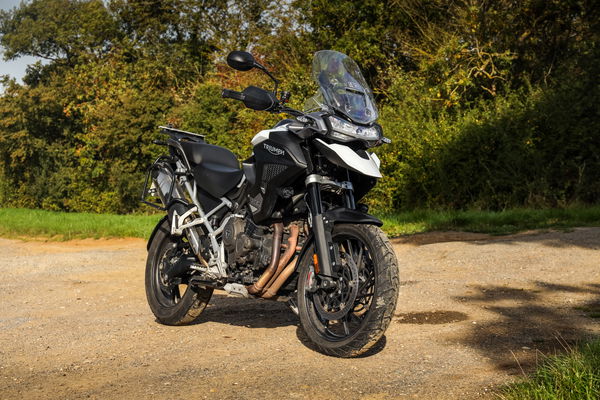Litre-bike super test - Real world superbikes
The boys from TWO give the big four's litre superbikes a going-over
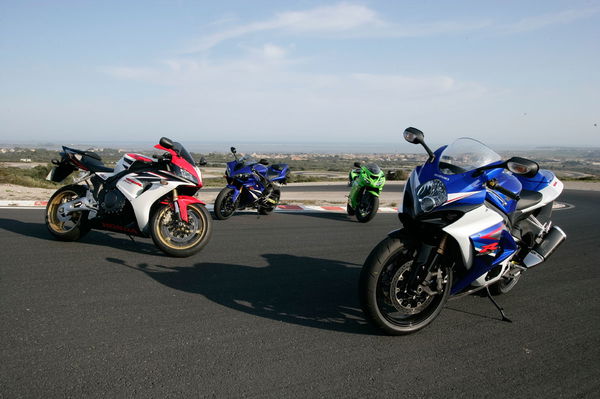
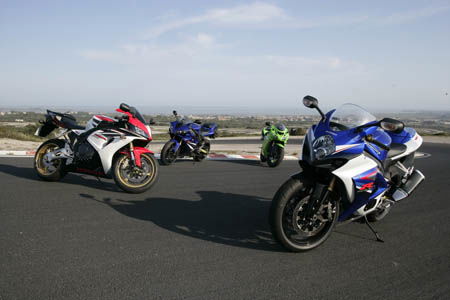
|
Is WSB exciting right now, or what? JT's Blade neck and neck with the R1 of Nitro and Troy C. Not to mention Max and the new K7. But what of the road bikes that lie beneath? Yes, what of...?
A few years ago World Superbikes had a problem. For a series that built its reputation on close-fought, hard racing it was becoming a bit, well, dull...
The organisers needed to spice things up a bit, level the playing field and reintroduce the element of excitement and close racing to the series.
Looking back to the the series' roots, namely in hot-rodded road bikes, it was clear what needed doing. The 750cc class, in which WSB's roots were grown, had been all-but abandoned by the
manufacturers. The buzz is now around 1000cc fours, so the rules were changed to allow these into the series, instantly spicing up the entry and so increasing spectator interest. Once again you could see your new road bike there on TV being raced around the world.
And to make it even closer all the competitors were now battling on the same brand of tyre. Which was a real leveller. In a corner a bike sticks to the road thanks to two palm-sized contact patches of rubber. If yours are better (or bigger) palms than the competition's then you have a huge advantage. Remove this element and the racing is closer and the net result a better reflection of man and bike. Inspiration for this test.
So to make this the definitive 1000cc group test TWO arranged exclusive acccess to Dunlop's test facility at Mireval in the South of France and for the track test all the bikes were fitted with
identical Dunlop Sportmax Qualifier tyres. The circuit was specifically designed to develop and test tyres and has a huge array of corners and cambers as well as perfect tarmac to put both tyre and bike to the ultimate test. With the rubber variables removed it was purely down to the bike's chassis and motor to impress our testers.
But unlike their race brothers these bikes don't just live on the track, so under the watchful eye of ex-WSB man James Whitham we rode them on the sun-drenched mountain roads of southern France. To the limit, and just a little bit beyond...
FIRST UP, WHAT'S NEW? With Kawasaki's ZX-10R and Honda's Fireblade nothing has changed for 2007, although the Blade does get a set of snazzy gold wheels and a new paint scheme. Last year Honda down-geared its 1000 and tweaked the chassis so this year it's purely colour changes. And it's the same for the Kawasaki. Last year saw an all-new ZX-10R with new frame, steering damper, engine mods and underseat pipes, so 2007 sees a few new stickers on the fairing and that's it. The big changes come from Suzuki and Yamaha.
Despite looking the same, the R1 has a whole host of modifications for 2007. I'll try and keep it brief. The engine now has four valves per cylinder head rather than five (like Rossi's MotoGP bike), it has R6-style fly-by-wire throttle, electronically operated intake funnels, a revised chassis, new brakes and a tweaked gearbox that comes with a slipper clutch as standard. So don't let the look lure you into thinking it's only a small tweak, Yamaha has thoroughly gone over the R1 and repositioned its target - but more of that later.
The GSX-R1000 has also enjoyed a major re-think. It didn't really need a redesign but Suzuki gave it one anyway. For 2007 the GSX-R gets some chassis changes, an electronic steering damper, new look, engine tweak and a new gizmo - for the first time on a production sportsbike the GSX-R1000 comes with the ability to switch to change engine mapping parameters - just like a full-on race bike. This, to be honest, is just another gadget to play with rather than concentrating on where you are actually going.
So, with all the bikes on the same Dunlop Sportmax Qualifier tyres, and an empty track at our disposal we set about the track comparison.Will the road bikes mimic the success of their race brothers?
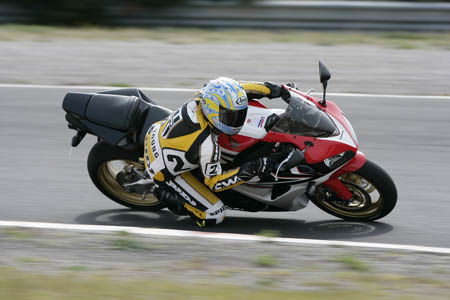 |
HONDA FIREBLADE
With a new circuit to learn, Honda's Fireblade is the obvious choice for a gentle few laps to suss the track. Despite being a ridiculously powerful and fast bike Honda has engineered a certain amount of calmness into the Blade. The engine is very forgiving and rather than having a powerband of any kind Honda has tuned the motor to simply provide a constantly strong amount of drive. With Blades of old this was often to their detriment as it made them feel a bit flat and lethargic but with this 2007 model the balance between power and control seems just about perfect. It's about confidence - the Honda breeds it by the skip-full.
While the motor reassures you that it's not about to rip your head off the Blade's chassis also implants a massive level of self-belief in the rider. It doesn't require an awful lot of thought to ride it fairly hard on track. Point the Honda where you want it to be and it just goes there, no fuss or effort involved. Evil reckons it reminds him of the first CBR600RR, which does have a very similar feeling of confidence about its handling. Every lap the Blade encourages you to try that little bit harder. It doesn't laugh at you when you're going slower but gently suggests that you may like to try a little harder next lap. Up until the point the pegs start scraping...
Now this was the Blade's major bug-bear. Like Honda's SP range the Blade comes with ridiculously long hero blobs. Daryll describes them as "scaffold poles" which isn't far off the mark. Okay, it's all very well and good to know that you have the bike leant over, but this is a sportsbike, it's meant to be leant over. The Blade's blobs are so long that we all 'enjoy' a slight scare at some point when the blob touch a bit too heavily and lift the back tyre slightly off the ground. To be fair they are easily removed, (so stop complaining -Ed) but why make them so long in the first place? It's almost as if Honda, having made such an easy handling bike, are
trying to stop riders getting too carried away.
"You know what?" said Evil after riding the Blade, "there were a
couple of years when the Blade was boring, but this isn't and it's really hard to say anything bad about it. "
True. very true. Honda has managed to put the character back into its already very confidence inspiring sports bike. A trick that Yamaha's new R1 hopes to emulate.
James Toseland, HANNspree Ten Kate Honda Fireblade
James says: "Now we have the traction control on the bike it's a lot less physical to ride. Last season, when the tyres were going off,
there was a lot of wheelspin and the bike wanted to go sideways rather than forwards. Now, with traction control, I can concentrate on the corner ahead rather than battling the thing through the
corner I've just exited and controlling the slide."
We say: As with the road bike, Honda has given James the
balanced chassis he needed. All that is left with the Blade is
the fine tuning.
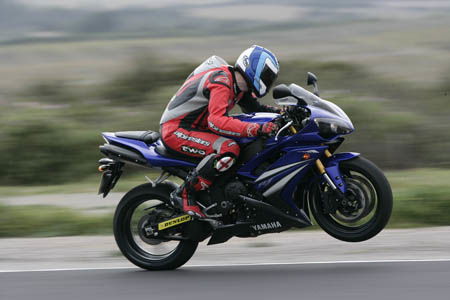 |
YAMAHA R1
With its new engine Yamaha has tried to inject a bit of life back into the R1. Since it first went 'underseat pipes' in 2004 the R1 has been targeted at the older sportsbike rider, or more mature at least. Hence no flash paint schemes. Grey pound?
This year Yamaha has given the R1 more life by adding variable intake funnels, which give the motor a mule-kick in power delivery at 10,000rpm. This leaves both Evil and myself confused - neither of us understanding why Yamaha have bothered. We both agree that the R1's engine is our least favourite, because of this two-stroke-like jump in the power delivery.
"The whole point about a 1000 is that you have a gob-full of low down grunt and power everywhere but the R1 doesn't. It's almost like a 600 and I'd get fed up of waiting for that 10,000rpm buzz," reckoned Evil. Hmm, yes, I agree, Evil, I agree.
Daryll, on the other hand, really likes the R1 because of its split
personality. "If you just want to ride around gently you can, but if you want to go ape you get it above 10,000rpm," says the wee man.
It might simply be the kind of rider you are, personally I find that going from one bike to another leaves the R1 feeling short of bottom end but ridiculously fast at the top when it kicks in - not something I want in a litre bike. Also the throttle response seems really snatchy going from a closed to partially open throttle, which is odd because the fly-by-wire system that Yamaha has developed is usually really good. It's especially noticeable in corners when you start applying the power.
Engine aside, which will always split opinions, the rest of the R1 is very impressive. The riding position is very comfortable on track and really brings your weight over the front of the bike. A lot like the R6, you feel like you're sitting far forward on the R1 and dominating its front end. Vicar. Like the old models the chassis is very well balanced. On track the low pegs do start to grind but it's nothing like as worrying as the Honda and only happens when you are pushing really hard. Really there isn't much to complain about on the Yamaha, the gearbox is superb, the slipper clutch very effective and the new six-piston brakes excellent, it's just the engine that failed to impress. Like the old R1 the new model is solid, secure and planted, it just doesn't feel as impressive engine-wise as the competition, especially the Kawasaki.
Troy Corser Yamaha Motor Italia YZF-R1
Troy says: "The chassis on our bike is definitely its strong point. It handles really well but we need to fine-tune the power curve and we are a bit down on bhp. The more time we have on the bike both at the track and the workshop on the dyno will sort this. I think they will find a fair bit more, we are still really early in its development and we aren't that far behind. The bike is only three months old and yet we are still on the pace. I'm really happy."
We say: The chassis is there, but power delivery isn't quite. Troy needs perfected power delivery so he can do his job. And new hose clips...
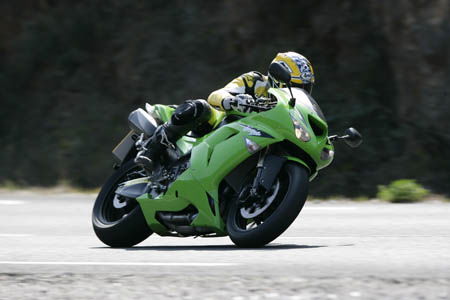 |
KAWASAKI ZX-10R
If there is one thing Kawasaki knows, it's how to build a powerful engine, it's just the chassis side of things it needs to work on. Like most Kawasakis the ZX-10R's motor is a stonker. It's a bit rough around the edges, but there's power everywhere and loads of grunt. Unlike the Yamaha the throttle response is smooth, but the chassis simply doesn't have the same poise when it comes to putting down the power.
"It may be a grunty engine, but you can't use any of it, as it just wants to shake its head," says Daryll.
Yes, despite the factory-fitted …hlins steering damper the ZX-10R is still the flightiest of the thousands, even on a smooth racetrack. Which is all part of its character I suppose. Evil liked the rawness of the Kawasaki and the thrills it provided. Turning the bike isn't the issue, the Kawasaki drops quickly into corners, but it just refuses to keep its front wheel down on the exit. If you don't mind wrestling a bike around a track then fine, the Kawasaki requires a lot of rider input, which some people may enjoy but when you compare it back-to-back with the competition it's just too much like hard work.
"Kawasaki should be commended on making a bike that's a bit raw and edgy," says Evil, "but on track it's my least favourite because it is such hard work to ride."
"It has a great engine, but NASA make great engines and they are only any use if you want to go to the moon, you wouldn't use one to pop to Tescos," reasons Daryll. Which is a good (if odd) point. A stunningly powerful engine doesn't necessarily make a stunning bike, what you need is a balanced overall package.
Regis Laconi PSG-1 team, Kawasaki WSB
Regis says: "This year it is a racehorse - like the logo of our PSG-1 team is a horse," (The year before Regis had likened it to a bull. Speaking of bull...)
We say: Regis is towing the company line. Like the road bike it's obvious that the race bike is fast enough, but the handling is errant. When they can get it set-up it works, but unfortunately for Regis this isn't very often the case, as the results show.
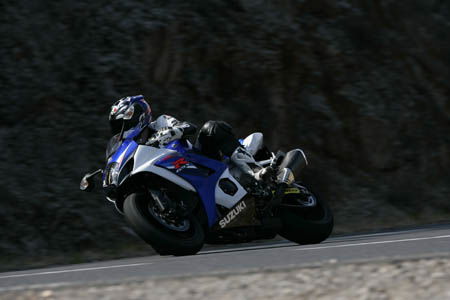 |
SUZUKI GSX-R
Despite keeping its rough edge, the latest generation of GSX-R1000 manages to combine raw aggression and character with an almost telepathic throttle response and power delivery. Out of the four bikes it's the easiest to ride on track, edging the Honda out of top spot, as it too has a feeling of utter control about it, only with an even faster engine.
With these bikes you really are hairing splits when it comes to the handling because there really isn't a bad handler amongst them, but the Suzuki has a slight edge over the competition in every department. Driving onto the start/finish straight the GSX-R is consistently the fastest bike because its engine is so responsive and chassis so balanced. On rippled, bumpy corner exits, where the Kawasaki (especially), Yamaha and Honda, are twitching their front ends the GSX-R remains totally in line. To be honest this
surprises me because I've always been a fan of Honda's electronic steering damper and although Suzuki has copied this idea with the GSX-R it doesn't look anything like as technologically advanced, but it works extremely well and come the end of the straight the GSX-R is fastest bike because of its exit speed.
"It's very planted and very easy to ride very fast indeed," is Evil's summary, "it isn't the best at everything, the Honda's brakes are better, but overall is the best on track, just
edging the Fireblade."
Max Biaggi, Alstare Suzuki Corona Extra WSB team
Max says: "When I find a good feeling with a bike, I can push hard. Sometimes small changes can make big differences, so we must use a step-by-step approach..."
We say: The best basic package. Nothing to whinge or moan about here, not even mid-season. Ahem.
TRACK RATING
So, to the crux of the matter. The new GSX-R has the feeling that every single component on the bike, including the rider, are
working together, rather than fighting each other. It may not have the sharpest brakes or sweetest gearbox, but as a package, on track, it clicks.
The Honda is the same, but with slightly less edge. It doesn't feel quite as focused as the GSX-R or as sharp in the corners, but is very reassuring to ride, especially for a bike with so much power. We found it really hard to split these two but if we had to make a call, all of us would plump for the Suzuki over the Honda - just.
Then it's a toss up between the Kawasaki and Yamaha. Both have raw edges but with the Yamaha that raw edge is more controllable, anywhere other than around the 10,000rpm transition, which put it third. Keeping the rev counter above 10,000rpm will appeal to some, but both myself and Evil Jim would rather have either the Suzuki or Honda's linear engine, they're just easier to live with. As for the ZX-10R, well do you want a thrill? Many riders of these bikes do. If you want to feel like a WSB rider fighting a wild horse then the Kawasaki is for you, just don't moan when Honda or Suzuki riders comes smoothly past you on a corner exit while you're holding on for grim death!
ROAD TO GLORY
...and also the road to a big, long list of Kawasaki parts. James Whitham gives you the lowdown on which of the sports 1000s is best for a weekend blast
This was the first time in three or four months I'd been out on the road on a big sports bike and the first time I'd got to chuck me leg over any of the '07 one litre sportsters. And I couldn't have picked a better place to do it, some of the best roads you'll ever find and
perfect weather to boot. I still find it hard to accept the fact that this counts as a job (it doesn't - Ed).
The first thing I have to say is that all these bikes are very good indeed. Performance wise, most road riders wouldn't be disappointed regardless of which one they chose to buy, the rest, like a lot in this world, comes down to what flicks yer switch aesthetically and emotionally. What follows is my own humble opinion.
The Kawasaki is definitely the most imposing to look at, and it's the same to ride. When you're bimbling along taking your time, or in traffic, the big green thing isn't happy. The uncomfortable riding position, understeer when you're cornering at slow speed, and drive-train backlash all make the Kwak the least town friendly of the four.
It was only when we got to the quiet country roads and I was able to give it the beans that I started to have some fun on the ZX-10R. This was because on the open road you're higher in the rev range and the backlash has gone. When you go faster in the corners the steering becomes neutral, the feeling through the bars is positive and, damn-it, even the riding position feels better.
The motor has more than enough power throughout, but unlike the R1 feels at its best through the middle of the rev-range while you are feeding it gears.
The ZX-10R is an uncompromising supersports bike that gets better the more you're able to thrash it. But let's face it, with 164bhp bullying just 209kg wet, on British roads that ain't gonna be too often.
With the R1 it's hard to understand how Yamaha have been able to produce a bike that is different in so many ways to the previous model - but looks almost the same.
The biggest (and much publicised) difference isYamaha , after 22 years (the FZ750 came out in 1985), are turning their back on five valve cylinder heads in favour of a more conventional four valve design. What they were after in 1985 was top end power, the three smaller inlet valves helped with this. What they need now is a flatter, more user-friendly power curve and more torque. In this respect, four valves are the way to go.
The Yam definitely has more grunt than last year but is still the most rev happy of the four. The motor smoothes out at the top, and seems at home when it's screaming. This could be the new variable length inlet trumpets that shorten electrically at 10k rpm, whatever, despite having more mid-range oomph the R1 is still a bit of a rev-monkey.
Steering is neutral at any corner speed and you get more feel coming back through the bars than you did on last year's bike. The new six-pot calipers move the Yam from bottom to the top of the pile when it comes to braking, and it's also got the comfiest riding position as well.
The new R1 is probably the best all-rounder of the bunch. If I had to choose one of these bikes for going out with yer spouse on Saturday, doing a track-day on the Sunday then riding to work on Monday morning, it'd be the Yam. But that's not what this test was about.
This test was about chasing around with the rest of the boys up and down perfect mountain roads, and for this, one bike you could never be disappointed with is the Blade. Every time I get on one I'm reminded what a well thought out, well finished, well balanced bike this is. It does everything annoyingly well. Steering isn't pin sharp but it's predictable and safe. The suspension copes with bumps really well without feeling sloppy, the steering damper is a gem, and weight transference when you hit the brakes is smooth and controlled. Everything about the Honda just... well... works.
The gearbox is slick and the motor is super smooth. In fact it's probably because it's so smooth that the Blade still doesn't feel as fast and brutal as the other three bikes, but lets face it, I'm talking fractions here. It's more than fast enough for anything you're ever going to want to do with it. Including touring.
The only (small) gripes I had with the Blade were the riding position, you seem to be perched higher up, on top of the bike instead of sitting 'in' it, but some riders prefer that stance anyway. And the fact that, for me, it lacks an 'edge' some how. Know what I mean ? It's a bit too nice. A bit too clinical. I do reckon though, a rider new to big sports bikes would find the CBR the easiest of the bunch to get on with.
The deep tank and those big twin pipes make the new GSX-R1000 seem a bulky bike, until you climb on board and get going. The big Suzuki steers so well for a litre bike. So much less effort is required to change direction and turn into a bend you'd swear you were riding some kind of over-bored 600.
The suspension feels smoother than last year's bike and unless you're very heavy or very light I'd recommend you don't start
twiddling away from the lovely standard settings. It's all well and good the bike coming with a stock shock that has high and low speed damping adjustment, but that means there's more potential to mess it up if you don't know what you're doing. If it ain't broke...
Motor wise too I found it difficult to pick fault with this bike. For me it felt the fastest bike on test with loads of predictable power everywhere and a nice, slightly 'raw' feel as it
catapulted you through the gears.
The power switch thing I'm not so sure about. I can understand why, in the wet you might use the 'C' setting where power is reduced right through the rev range giving a maximum of about 80bhp. But I couldn't get on with the 'B' position at all. Here the power is reduced regardless of revs until the throttle is fully open, at which point full power is delivered. With 'B' I found myself coming out of a bend and suddenly 50bhp came in when I wasn't expecting it. It was like riding some kind of crazy turbo bike. But forget all that, on dry roads we just stuck the switch on 'A' (100%) and let rip!
Overall the Suzuki was the fastest, sharpest handling and most rewarding to ride of the four. It makes you
concentrate on what you're feeling through your arse, and the 100 yards of road in front of you.
CONCLUSION
As James has already spouted forth, the sports 1000 market is so close that you really can't pick a bad one. Each bike offers slightly more, or less, of one aspect - which is the only real way to split them.
For the experienced or inexperienced 1000cc rider, Suzuki's GSX-R1000 is the ultimate tool. It not only offers a poised and balanced chassis, but also enormous levels of power. Add to that the 'bling' factor of high and low speed damping, slipper clutch, gear indicator and the new electronic power limiting gizmo and it's hard to see just how Suzuki can produce such a bike and still make it the cheapest of the 1000s. It's a bargain and a stunning overall package.
Honda's Fireblade does the very impressive trick of making a sports 1000 feel unintimidating to ride. Despite churning out a huge 157bhp the Blade is the easiest to live with and has a feeling of quality about it. Although it lacks the 'wow' gizmos (it doesn't even have a slipper clutch) the Blade still manages to keep up with the opposition due to excellent design and engineering.
Yamaha's R1 splits opinions. The new aggressive and characterful R1 is certainly a departure when it comes to attitude, but is this what you want as a rider? Yes, the kickin' power is fun, but everyday? Or on a wet road for that matter. It is by no means a bad bike, but the Suzuki and Honda were far easier to live with.
And finally we have the Kawasaki. The problem with the ZX-10R is that the competition is so good. It has a stunning engine, aggression by the bag load and a real mean streak, which is certainly something that should be commended. But, and it is a big BUT, the rest are better in all the important areas. If you like big green bikes then you will love this one, but you will have to live with the knowledge it isn't the best at anything.
SPECS | |||
| HONDA CBR1000RR Fireblade TYPE - SUPERSPORTS PRODUCTION DATE - 2007 PRICE NEW - £8999 ENGINE CAPACITY - 998cc POWER - 157.6bhp@11,300rpm TORQUE - 79.6lb.ft@8700rpm WEIGHT - 176kg SEAT HEIGHT - 831mm FUEL CAPACITY - 18L TOP SPEED - 170.4mph 0-60 - n/a TANK RANGE - N/A | KAWASAKI ZX-10R TYPE - SUPERSPORTS PRODUCTION DATE - 2007 PRICE NEW - £8800 ENGINE CAPACITY - 998cc POWER - 164bhp@11,400rpm TORQUE - 81.7lb.ft@7900rpm WEIGHT - 175kg SEAT HEIGHT - 825mm FUEL CAPACITY - 17L TOP SPEED - 186.1mph 0-60 - n/a TANK RANGE - N/A | SUZUKI GSX-R1000 TYPE - SUPERSPORTS PRODUCTION DATE - 2007 PRICE NEW - £8949 ENGINE CAPACITY - 999cc POWER - 165.7bhp@11,800rpm TORQUE - 78.8lb.ft@9900rpm WEIGHT - 172kg SEAT HEIGHT - 810mm FUEL CAPACITY - 18L TOP SPEED - 176.7mph 0-60 - n/a TANK RANGE - N/A | YAMAHA YZF-R1 TYPE - SUPERSPORTS PRODUCTION DATE - 2007 PRICE NEW - £8999 ENGINE CAPACITY - 998cc POWER - 153.5bhp@10,600rpm TORQUE - 79.5lb.ft@8300rpm WEIGHT - 177kg SEAT HEIGHT - 835mm FUEL CAPACITY - 18L TOP SPEED - 174.4mph 0-60 - n/a TANK RANGE - N/A |

A few years ago World Superbikes had a problem. For a series that built its reputation on close-fought, hard racing it was becoming a bit, well, dull...
The organisers needed to spice things up a bit, level the playing field and reintroduce the element of excitement and close racing to the series.
Looking back to the the series' roots, namely in hot-rodded road bikes, it was clear what needed doing. The 750cc class, in which WSB's roots were grown, had been all-but abandoned by the manufacturers. The buzz is now around 1000cc fours, so the rules were changed to allow these into the series, instantly spicing up the entry and so increasing spectator interest. Once again you could see your new road bike there on TV being raced around the world.
And to make it even closer all the competitors were now battling on the same brand of tyre. Which was a real leveller. In a corner a bike sticks to the road thanks to two palm-sized contact patches of rubber. If yours are better (or bigger) palms than the competition's then you have a huge advantage. Remove this element and the racing is closer and the net result a better reflection of man and bike. Inspiration for this test.
So to make this the definitive 1000cc group test we arranged exclusive acccess to Dunlop's test facility at Mireval in the South of France and for the track test all the bikes were fitted with identical Dunlop Sportmax Qualifier tyres. The circuit was specifically designed to develop and test tyres and has a huge array of corners and cambers as well as perfect tarmac to put both tyre and bike to the ultimate test. With the rubber variables removed it was purely down to the bike's chassis and motor to impress our testers.
But unlike their race brothers these bikes don't just live on the track, so under the watchful eye of ex-WSB man James Whitham we rode them on the sun-drenched mountain roads of southern France. To the limit, and just a little bit beyond...
FIRST UP, WHAT'S NEW? With Kawasaki's ZX-10R and Honda's Fireblade nothing has changed for 2007, although the Blade does get a set of snazzy gold wheels and a new paint scheme. Last year Honda down-geared its 1000 and tweaked the chassis so this year it's purely colour changes. And it's the same for the Kawasaki. Last year saw an all-new ZX-10R with new frame, steering damper, engine mods and underseat pipes, so 2007 sees a few new stickers on the fairing and that's it. The big changes come from Suzuki and Yamaha.
Despite looking the same, the R1 has a whole host of modifications for 2007. I'll try and keep it brief. The engine now has four valves per cylinder head rather than five (like Rossi's MotoGP bike), it has R6-style fly-by-wire throttle, electronically operated intake funnels, a revised chassis, new brakes and a tweaked gearbox that comes with a slipper clutch as standard. So don't let the look lure you into thinking it's only a small tweak, Yamaha has thoroughly gone over the R1 and repositioned its target - but more of that later.
The GSX-R1000 has also enjoyed a major re-think. It didn't really need a redesign but Suzuki gave it one
anyway. For 2007 the GSX-R gets some chassis changes, an electronic steering damper, new look, engine tweak and a new gizmo - for the first time on a production sportsbike the GSX-R1000 comes with the ability to switch to change engine mapping parameters - just like a full-on race bike. This, to be honest, is just another gadget to play with rather than concentrating on where you are actually going.
So, with all the bikes on the same Dunlop Sportmax Qualifier tyres, and an empty track at our disposal we set about the track comparison. Will the road bikes mimic the success of their race brothers?

